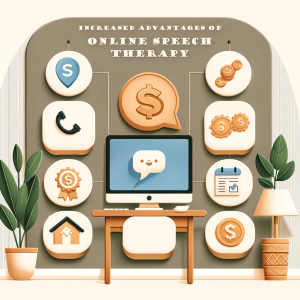


In an era where digital innovation is revolutionizing healthcare, online speech therapy emerges as a beacon of hope for adults grappling with neurogenic speech and language disorders. Often overshadowed by traditional face-to-face therapy, the virtual approach is not just a mere alternative but a transformative avenue that brings speech therapy into the comfort and privacy of one’s home. This method is particularly pivotal for individuals recovering from stroke, where the journey to regain speech and language skills is both critical and deeply personal.

Unlike the general discussions that merely skim the surface of teletherapy’s convenience, this article delves deeper, exploring the nuanced ways in which online speech therapy aligns with the unique needs and lifestyles of those it aims to serve. It’s not just about bringing the therapist to your screen; it’s about reshaping the therapy experience to fit the intricate puzzle of post-stroke recovery and other neurogenic conditions such as Traumatic Brain Injury (TBI) and Parkinson’s Disease.
The concept of ‘Passion-Based Therapy‘ stands at the forefront of this online revolution. This approach is not just about discussing what patients love; it’s about actively integrating these passions into the therapy process. Whether it’s a cherished hobby, a beloved art form, or a lifelong interest, therapy sessions are uniquely tailored to resonate with the patient’s personal interests, thereby enriching the therapeutic experience and enhancing engagement and motivation.
As we navigate through this exploration, we’ll uncover the layers of effectiveness, practicality, and emotional connectivity that online speech therapy offers. This is especially crucial for adults post-stroke, whose recovery journey is as much about regaining speech and language as it is about reclaiming their identity and independence. Through this lens, we aim to present a comprehensive view of online speech therapy, not just as a service, but as a pathway to empowerment and renewed confidence for those embarking on this challenging yet hopeful journey of recovery.
In the journey to demystify online speech therapy, it’s essential to start at the foundation, unraveling its core and comprehending its role in modern healthcare. This understanding lays the groundwork for appreciating its effectiveness, especially in the context of neurogenic disorders.
Online speech therapy, often termed teletherapy or virtual speech-language pathology, represents a significant leap in healthcare delivery. At its heart, it’s the provision of speech and language therapy services through digital platforms, predominantly video conferencing tools. This approach transcends geographical barriers, bringing specialized care to individuals irrespective of their location.
Uniqueness in Approach: Unlike traditional settings, online therapy isn’t confined within the walls of a clinic. It leverages technology to create a virtual space that is both therapeutic and familiar, as sessions are conducted in the patient’s own environment. This aspect is crucial for adults with neurogenic disorders, for whom travel to a physical location can be a significant hurdle.
Technology as an Enabler: The use of technology in online speech therapy isn’t just a necessity; it’s an enhancement. Digital tools and interactive software not only facilitate communication between therapist and patient but also introduce innovative methods for therapy. These tools range from virtual whiteboards for visual assistance to specialized apps for speech practice and progress tracking.

The transition to online speech therapy isn’t merely a trend; it’s a paradigm shift in how speech-language pathology services are delivered and experienced. This shift represents a broader movement in healthcare towards telehealth, propelled by advancements in technology and a changing societal landscape that values convenience and accessibility.
Bridging the Accessibility Gap: One of the most compelling aspects of online therapy is its ability to bridge gaps in access. Many adults with neurogenic disorders live in areas where specialized speech therapy services are scarce or non-existent. Online therapy breaks down these geographical barriers, providing access to quality care regardless of location.
Personalized and Flexible Care: Online speech therapy offers a level of personalization and flexibility seldom found in traditional settings. Therapists can tailor sessions to the individual’s environment, schedule, and specific needs. This customization is particularly beneficial for stroke survivors, whose recovery timelines and capabilities vary widely.
A New Perspective on Patient Engagement: Engaging patients in their therapy journey is pivotal, and the online medium offers unique opportunities for engagement. The comfort of being in a familiar environment, combined with the use of interactive digital tools, often results in higher levels of participation and motivation. Moreover, the ability to integrate personal interests and passions into therapy sessions makes the experience more meaningful and effective.
In understanding the essence of online speech therapy, we begin to see its potential not just as a service, but as a transformative experience for individuals recovering from stroke and other neurogenic disorders. It’s a blend of innovation, personalization, and accessibility, tailored to meet the unique needs of each patient in their pursuit of improved communication and a better quality of life.
Exploring the effectiveness of online speech therapy involves a deep dive into its impact, outcomes, and the overarching benefits it brings to individuals with neurogenic speech and language disorders. This section discusses how online therapy stands up against traditional methods, specifically in terms of clinical outcomes, patient satisfaction, and overall accessibility.
A cornerstone of evaluating the effectiveness of any therapeutic intervention is evidence-based practice. In the realm of online speech therapy, numerous studies and clinical trials have provided a strong foundation supporting its efficacy.
The effectiveness of therapy is not solely measured by clinical outcomes but also by how it resonates with the patients themselves. Online speech therapy offers unique advantages that align with the needs and preferences of its users.

The referenced article underscores several key points that align with the observed benefits of online speech therapy:
In light of these findings, it’s evident that online speech therapy is not just a viable alternative to traditional therapy but a forward-thinking approach that aligns with modern healthcare needs. Its effectiveness is backed by both clinical evidence and the tangible benefits it offers to patients, particularly those recovering from neurogenic disorders like stroke.
In summary, the effectiveness of online speech therapy is multifaceted, combining clinical efficacy with personalized care, accessibility, and patient satisfaction. It’s a testament to how technology can enhance healthcare delivery, making it more inclusive, effective, and patient-centered.
When examining the impact of online speech therapy, a special focus must be placed on its role in assisting stroke survivors. Stroke often leaves individuals grappling with aphasia, dysarthria, or other speech and language impairments, profoundly affecting their ability to communicate and, by extension, their quality of life. Online therapy emerges not just as a method of treatment, but as a beacon of hope and innovation in the journey towards recovery and reconnection.
Post-stroke recovery is a path filled with unique challenges and complexities. Each individual’s journey is distinct, with varying degrees of speech and language impairment.
The integration of technology in online speech therapy offers unique advantages, particularly for those recovering from a stroke. These technological aspects are seldom discussed in traditional therapy narratives but play a crucial role in the effectiveness of online therapy.

One of the less discussed yet critical aspects of stroke recovery is the risk of social isolation. Online speech therapy addresses this issue head-on, offering more than just clinical treatment.
A critical yet often overlooked aspect of speech therapy for stroke survivors is the integration of therapy goals with daily life activities. Online therapy offers unique opportunities in this area.
Looking forward, the role of online speech therapy in stroke recovery is not only about addressing speech and language deficits but also about adopting a holistic approach that considers the emotional, psychological, and social aspects of recovery.
In summary, the special focus on stroke and online therapy reveals a multifaceted approach that goes beyond traditional therapy methods. It’s a blend of personalization, technological innovation, and emotional support, tailored to meet the unique challenges faced by stroke survivors in their journey towards recovery and reconnection.
Delving into the realm of online speech therapy reveals a spectrum of advantages that extend beyond the conventional benefits often discussed. These advantages resonate deeply with adults suffering from neurogenic disorders, offering them not just therapy, but a pathway to enhanced communication and improved quality of life in ways that are both innovative and impactful.
One of the less explored yet significant advantages of online speech therapy is the capacity for detailed data collection and progress tracking. This aspect is crucial for tailoring therapy to the individual’s evolving needs.
The integration of AR and VR into online speech therapy is a pioneering approach that offers immersive and interactive experiences, making therapy more engaging and effective.
Online speech therapy breaks down the barriers of location, allowing clients to access specialist expertise that might not be available locally.
An often-overlooked advantage of online speech therapy is the potential for asynchronous therapy options. This can be particularly beneficial for clients who have erratic schedules or those who prefer to work at their own pace.
By embracing these innovative and client-centric advantages, online speech therapy offers a future-forward approach to speech and language pathology. It’s not just about overcoming the limitations of traditional therapy; it’s about redefining the therapy experience to be more inclusive, effective, and aligned with the evolving needs of today’s clients.
Online speech therapy is not just a digital version of traditional methods; it’s an evolving landscape of innovative techniques and approaches that redefine therapy for neurogenic disorders. These techniques, often unexplored in mainstream discussions, harness the potential of technology to offer more than just convenience—they offer a reimagined pathway to communication and recovery.
One of the cutting-edge approaches in online speech therapy is the use of artificial intelligence (AI) and machine learning. These technologies bring a level of personalization and efficiency to therapy that was previously unattainable.
The concept of gamification in therapy is a novel approach that transforms traditional exercises into engaging and interactive games. This technique is particularly effective in maintaining client engagement and motivation.
Social media platforms offer unique opportunities for therapy, a facet often overlooked in the speech therapy domain. These platforms can be used to create supportive communities and facilitate peer-to-peer interaction.
Asynchronous video analysis is a technique that allows therapists to review client-recorded videos at their convenience, providing feedback and guidance outside of real-time sessions.
By integrating these advanced techniques and approaches, online speech therapy not only adapts to the digital age but also leads the way in offering innovative, engaging, and effective therapy options. These methods reflect a deep understanding of the unique needs of adults with neurogenic disorders, emphasizing the importance of personalized, engaging, and flexible therapy solutions.
While the focus often falls on stroke recovery in the context of speech therapy, the realm of online therapy extends its reach to a broader spectrum of neurogenic disorders. Each of these conditions presents unique challenges and necessitates tailored approaches, which online therapy is particularly well-suited to provide. Exploring these conditions and the specific benefits of online therapy for each reveals the versatility and adaptability of this treatment modality.
Traumatic Brain Injury presents a diverse range of communication challenges, often differing significantly from person to person. Online speech therapy offers a highly customizable platform to address these varied needs.
Parkinson’s Disease often leads to speech difficulties like dysarthria, characterized by slurred or slow speech. Online therapy can be particularly beneficial in addressing these issues.
For progressive neurological conditions like Multiple Sclerosis (MS) or Amyotrophic Lateral Sclerosis (ALS), speech therapy needs evolve over time. Online therapy’s flexibility makes it ideal for adapting to these changing needs.
Aphasia, often resulting from stroke or brain injury, impairs the ability to communicate effectively. Online therapy introduces innovative approaches to enhance communication for individuals with aphasia.
Online speech therapy offers a dynamic and flexible approach to treating a wide range of neurogenic disorders. Its adaptability to individual needs, combined with the innovative use of technology, makes it a valuable tool in the management and rehabilitation of various speech and language impairments.
As we look towards the future of speech therapy, the integration of telehealth emerges as a transformative force, not just as a service delivery model, but as an innovation hub that reshapes therapeutic approaches. The evolution of telehealth in speech therapy is paving the way for more inclusive, accessible, and advanced care, particularly for adults with neurogenic disorders.

One of the most exciting prospects in the future of telehealth in speech therapy is the potential for global collaboration and knowledge exchange. This aspect of telehealth is often under-discussed but holds immense potential.
The utilization of big data in telehealth is a frontier yet to be fully explored in speech therapy. Predictive analytics can revolutionize how therapy is planned and delivered.
The future of telehealth in speech therapy also points towards the integration of wearable technology, offering continuous monitoring and support beyond traditional therapy sessions.
Artificial Intelligence (AI) is set to play a pivotal role in the future of telehealth, offering unprecedented levels of personalization in therapy.
The future of speech therapy through telehealth is not just an extension of the present but a leap into a future where therapy is more accessible, personalized, and effective. It’s a future that embraces technological innovation for the betterment of client care, particularly for those with neurogenic disorders.

Seth Koster M.S. CCC-SLP




Understanding Speech Problems After TBI - American Online Speech Therapy says:
[…] Online speech therapy, on the other hand, has ushered in a new era of convenience and accessibility.…With the use of digital platforms, therapy sessions can be conducted from anywhere, significantly reducing the barriers of distance and physical mobility. This has been particularly beneficial during times when in-person interactions are limited, such as during the recent global health crises. […]